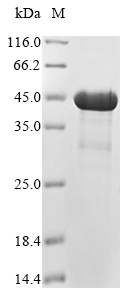Recombinant Mouse 5-AMP-activated protein kinase subunit beta-1 (Prkab1)
CAT:
399-CSB-EP889918MO-02
Size:
100 µg
Price:
Ask
- Availability: 24/48H Stock Items & 2 to 6 Weeks non Stock Items.
- Dry Ice Shipment: No




Recombinant Mouse 5-AMP-activated protein kinase subunit beta-1 (Prkab1)
- CAS Number: 9000-83-3
- Gene Name: Prkab1
- UniProt: Q9R078
- Expression Region: 2-270aa
- Organism: Mus musculus
- Target Sequence: GNTSSERAALERQAGHKTPRRDSSGGAKDGDRPKILMDSPEDADIFHSEEIKAPEKEEFLAWQHDLEANDKAPAQARPTVFRWTGGGKEVYLSGSFNNWSKLPLTRSQNNFVAILDLPEGEHQYKFFVDGQWTHDPSEPIVTSQLGTVNNIIQVKKTDFEVFDALMVDSQKCSDVSELSSSPPGPYHQEPYMSKPEERFKAPPILPPHLLQVILNKDTGISCDPALLPEPNHVMLNHLYALSIKDGVMVLSATHRYKKKYVTTLLYKPI
- Tag: N-terminal 6xHis-tagged
- Source: E.coli
- Field of Research: Metabolism
- Assay Type: In Stock Protein
- Relevance: Non-catalytic subunit of AMP-activated protein kinase, an energy sensor protein kinase that plays a key role in regulating cellular energy metabolism. In response to reduction of intracellular ATP levels, AMPK activates energy-producing pathways and inhibits energy-consuming processes: inhibits protein, carbohydrate and lipid biosynthesis, as well as cell growth and proliferation. AMPK acts via direct phosphorylation of metabolic enzymes, and by longer-term effects via phosphorylation of transcription regulators. Also acts as a regulator of cellular polarity by remodeling the actin cytoskeleton; probably by indirectly activating myosin. Beta non-catalytic subunit acts as a scaffold on which the AMPK complex assembles, via its C-terminus that bridges alpha and gamma subunits.
- Purity: Greater than 85% as determined by SDS-PAGE.
- Activity: Not Test
- Length: Full Length of Mature Protein
- Form: Liquid or Lyophilized powder
- Buffer: If the delivery form is liquid, the default storage buffer is Tris/PBS-based buffer, 5%-50% glycerol. If the delivery form is lyophilized powder, the buffer before lyophilization is Tris/PBS-based buffer, 6% Trehalose, pH 8.0.
- Reconstitution: We recommend that this vial be briefly centrifuged prior to opening to bring the contents to the bottom. Please reconstitute protein in deionized sterile water to a concentration of 0.1-1.0 mg/mL.We recommend to add 5-50% of glycerol (final concentration) and aliquot for long-term storage at -20℃/-80℃. Our default final concentration of glycerol is 50%. Customers could use it as reference.
- Molecular Weight: 36.1 kDa
- References & Citations: "Large scale localization of protein phosphorylation by use of electron capture dissociation mass spectrometry." Sweet S.M., Bailey C.M., Cunningham D.L., Heath J.K., Cooper H.J. Mol. Cell. Proteomics 8:904-912 (2009)
- Storage Conditions: The shelf life is related to many factors, storage state, buffer ingredients, storage temperature and the stability of the protein itself. Generally, the shelf life of liquid form is 6 months at -20℃/-80℃. The shelf life of lyophilized form is 12 months at -20℃/-80℃.
